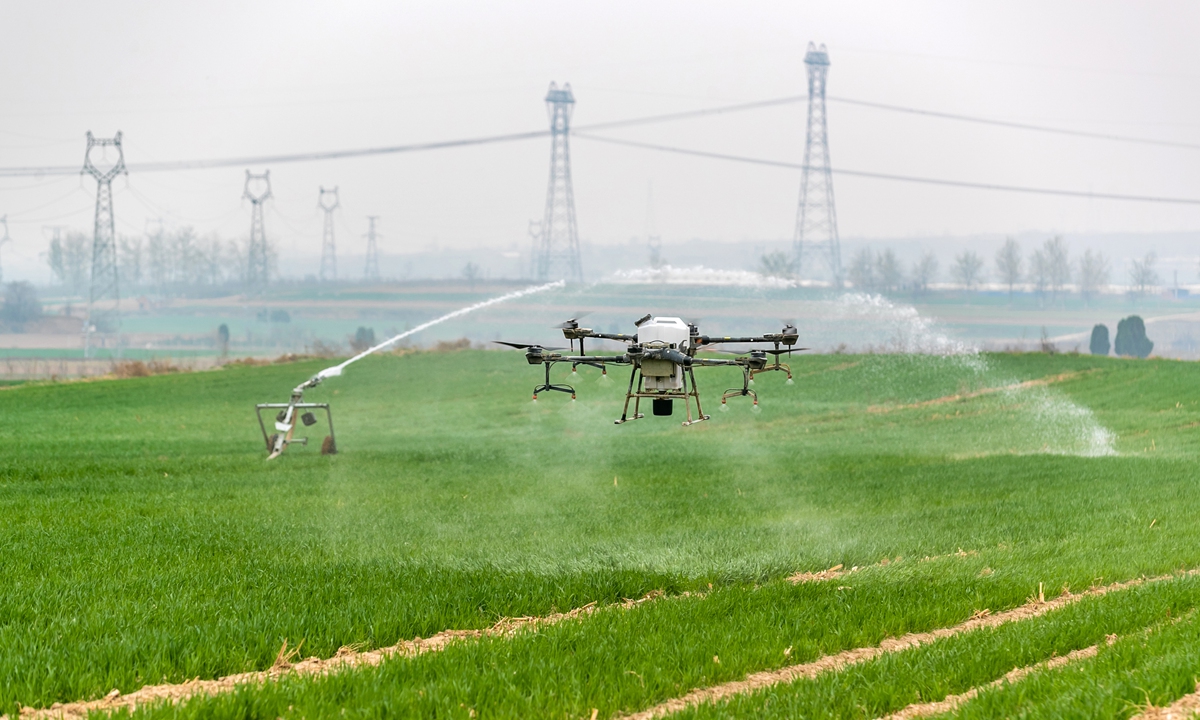
An unmanned plant protection machine fertilizes wheat fields in Yuncheng city, North China's Shanxi Province on March 21, 2022. Photo: cnsphoto
Chinese meteorologists launched monitoring and assessment services for winter wheat distribution across the country that is based on remote sensing satellite technology.
The monitoring accuracy reached a resolution of 30 meters from space, and meteorology departments at the national, provincial, municipal and county levels have joined forces to promote such satellite technology applications, the Global Times learned from project insiders.
The new satellite-powered service could address the previous lack-of-precision problems in weather forecasts for grain production, Zhang Mingwei, an associate research fellow with the National Satellite Meteorological Center who is in charge of the project, told the Global Times on Tuesday.
The satellite service would offer not only the distribution map of winter wheat and data on the planting area in different regions, but also dynamic reports of yearly distribution changes, which would support summer grain production forecasts and assessment of the impact of weather disasters, according to the center.
The advancement of satellite technology and China's growing capability in satellite applications have made it possible to address the previous problems. The Gaofen-6 satellite, the country's first high-precision agricultural observation satellite, not only has a resolution up to 2 meters, but also can tell different crops [such as wheat and beans] based on their spectral characteristics, Zhang said.
Gaofen-1 is another remote sensing satellite of the project, Zhang added.
Starting this year, such service would primarily focus on staple crops such as winter wheat, covering cities and provinces such as Beijing, Tianjing, Hebei, Shanxi, Shaanxi, Jiangsu, Anhui and Hubei.
According to Zhang, these are the main production areas for China's winter wheat, taking up 90 percent of the planting area for the crop which are also prone to drought in summer, changeable weather in harvest season in May and June, as well as droughts and flooding in the October planting season.
Monitoring crops and providing weather forecasts, which includes early warning for droughts and floods as well as potential pest disasters, would facilitate the policymaking to support farmers, Zhang told the Global Times in the Tuesday exclusive interview.
Starting next year, corn in the main planting area in Northeast China and Huanghuai region - along the Yellow and Huaihe rivers - will be the next observation target, Zhang revealed.
Rice would be next with its major planting areas in Northeast China and five provinces located in the middle and lower reaches of the Yangtze River such as Hubei and Anhui provinces.
After the observation service for staple crops, the same services would be launched for special economic crops from 2024-25.
Zhang said China would also promote overseas monitoring for grain growing and production forecast services in the future.
The National Satellite Meteorological Center has established a special department for international services, and the Fengyun satellite family would be deployed, Xian Di, deputy director of the Fengyun Satellite International User Service Center , told the Global Times on Tuesday.
Such services would become available for overseas users in countries along the route of China-proposed Belt and Road Initiative as soon as next year.




